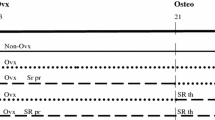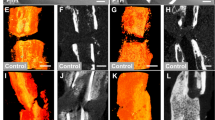Abstract
In this paper, the effect of osteoprotegerin (OPG) on slowing down the resorption process of heterotopically induced bone tissue is described. The induced ossicle is resorbed ex inactivitate. This system mimics osteoporosis in immobilised skeletal bones. Bone induction was achieved in BALB/c mice after the injection of the suspension of 3 × 106 HeLa cells into thigh muscle of animals immuno-suppressed by a single dose of hydrocortisone. To slow down the process of resorption we applied OPG and measured quantitatively the effect by weighing the mass of mineral deposited in the induced ossicle after hydrolysis of soft tissues surrounding the induced ossicles. As the effect of application of OPG more than 340–540% of bone mineral is found in the induced ossicles following nine applications of 0.05 mg OPG per mouse, every second day — in comparison to the control animals.
Similar content being viewed by others
References
Anderson H.C., Marker P.C. and Fogh J. 1964. Formation of tumors containing bone after intramuscular injection of transformed human amnion cells (FL) into cortisone-treated mice. Am. J. Pathol. 54: 507–513.
Burger E.H., van der Meer J.W.M. and Nijweide J. 1984. Osteoclast formation from mononuclear phagocytes: Role of bone forming cells. J. Cell Biol. 99: 1901–1906.
Grigoriadis A., Wang Z., Cechini M., Hofstetter W., Felix R., Fleisch H. and Wagner E. 1994. c-Fos. - a key regulator of osteoclast - macrophage lineage determination and bone remodeling. Science 266: 443–444.
Hofbauer L.C. and Heufelder A.E. 1998. Osteoprotegerin and its cognate ligand: a new paradigm of osteoclastogenesis. Eur. J. Endocrinol. 139: 152–154.
Kochanowska I.E., Włodarski K., Wojtowicz A. and Ostrowski K. 2002a. BMP-4 and BMP-6 involvement in the osteogenic properties of the HeLa cell line. Exp. Biol.Med. 227: 57–62.
Kochanowska I.E., Włodarski K., Wojtowicz A., Niemira K. and Ostrowski K. 2002b. Osteogenic properties of various HeLa cell lines and the BMP family genes expression. Ann. Transplant. 7: 61–66.
Martin T.J. and Ng K.W. 1994. Mechanism by which cells of the osteoblast lineage control osteoclast formation and activity. J. Cell Biochem. 56: 357–366.
Suda T., Udagawa N., Nakamura I., Miyaura C. and Takahashi N. 1995. Modulation of osteoclast differentiation by local factors. Bone 17(Suppl. 2): 87S–91S.
Suda T., Kobayashi K., Jimi E., Udagawa N. and Takahashi N. 2001. The molecular basis of osteoclast differentiation and activation. Novartis Found Symp. pp. 235–247.
Sun L.J., Peterson B.R. and Verdine G.L. 1997. Dual role of the NFAT insert region in DNA recognition and cooperative contacts to AP-1. Proc. Natl Acad. Sci. USA 94: 4919–4924.
Takai H., Kanematsu M., Yanopk K., Tsuda E., Higashio K., Ikeda K., Watanabe K. and Yamada Y. 1998. Transforming growth factor beta stimulates the production of osteoprotegerin/ osteoclastogenesis inhibitory factor by bone marrow stromal cells. J. Biol. Chem. 273: 27091–27096.
Takayanagi H., Ogasawara K., Hida S., Chiba T., Murata S., Sato K., Takaoka A., Yokochi T., Oda H., Tanaka K., Nakamura K. and Taniguchi T. 2000. T-cell-mediated regulation of osteoclastogenesis by signalling cross-talk between RANKL and IFN-gamma. Nature 408: 600–605.
Takayanagi H., Kim S., Matsudo K., Suzuki H., Suzuki T., Sato K., Yokochi T., Oda H., Nakamura K., Ida N., Wagner E.F. and Taniguchi T. 2002a. RANKL maintaines bone homeostasis through s-Fos-dependent induction of interferon beta. Nature 416: 744–749.
Takayanagi H., Kim S., Koga T., Nishina H., Isshiki M., Yoshida H., Saiura A., Isobe M., Yokochi T., Inoue J., Wagner E.F., Mak T.W., Kodama T. and Taniguchi T. 2002b. Induction and activation of the transcription factor NFATc1 (NFAT2) integrate RANKL signaling in terminal differentiation of osteoclasts. Dev. Cell. 3(6): 889–901.
Teitelbaum S.L. 2000. Bone resorption by osteoclasts. Science 289: 1504–1508.
Yasuda H., Shima N., Nakagawa N., Yamaguchi K., Kinosaki M., Goto M., Mochizuki S.J., Tsuda E., Morinaga T., Udagawa N., Takahashi N., Suda T. and Hifashiomi K. 1999. A novel molecular mechanism modulating osteoclast differentiation and function. Bone 25: 109–113.
Author information
Authors and Affiliations
Corresponding author
Rights and permissions
About this article
Cite this article
Kochanowska, I., Włodarski, K., Pienkowski, M. et al. Influence of Osteoprotegerin (OPG) on Resorption of Heterotopically Induced Ossicle. Cell Tissue Banking 5, 125–128 (2004). https://doi.org/10.1023/B:CATB.0000034095.83717.23
Issue Date:
DOI: https://doi.org/10.1023/B:CATB.0000034095.83717.23




